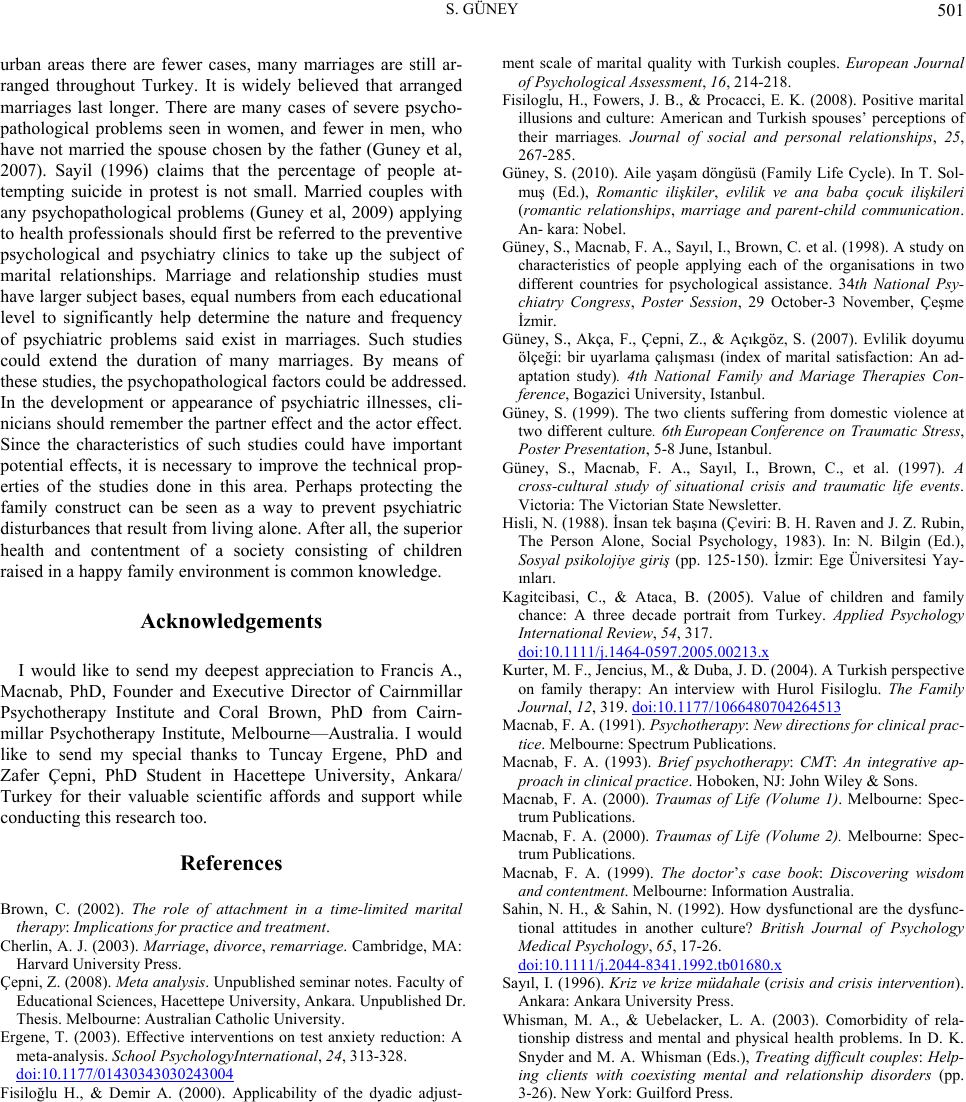
S. GÜNEY 501
urban areas there are fewer cases, many marriages are still ar-
ranged throughout Turkey. It is widely believed that arranged
marriages last longer. There are many cases of severe psycho-
pathological problems seen in women, and fewer in men, who
have not married the spouse chosen by the father (Guney et al,
2007). Sayil (1996) claims that the percentage of people at-
tempting suicide in protest is not small. Married couples with
any psychopathological problems (Guney et al, 2009) applying
to health professionals should first be referred to the preventive
psychological and psychiatry clinics to take up the subject of
marital relationships. Marriage and relationship studies must
have larger subject bases, equal numbers from each educational
level to significantly help determine the nature and frequency
of psychiatric problems said exist in marriages. Such studies
could extend the duration of many marriages. By means of
these studies, the psychopathological factors could be addressed.
In the development or appearance of psychiatric illnesses, cli-
nicians should remember the partner effect and the actor effect.
Since the characteristics of such studies could have important
potential effects, it is necessary to improve the technical prop-
erties of the studies done in this area. Perhaps protecting the
family construct can be seen as a way to prevent psychiatric
disturbances that result from living alone. After all, the superior
health and contentment of a society consisting of children
raised in a happy family environment is common knowledge.
Acknowledgements
I would like to send my deepest appreciation to Francis A.,
Macnab, PhD, Founder and Executive Director of Cairnmillar
Psychotherapy Institute and Coral Brown, PhD from Cairn-
millar Psychotherapy Institute, Melbourne—Australia. I would
like to send my special thanks to Tuncay Ergene, PhD and
Zafer Çepni, PhD Student in Hacettepe University, Ankara/
Turkey for their valuable scientific affords and support while
conducting this research too.
References
Brown, C. (2002). The role of attachment in a time-limited marital
therapy: Implications for practice and treatment.
Cherlin, A. J. (2003). Marriage, divorce, remarriage. Cambridge, MA:
Harvard University Press.
Çepni, Z. (2008). Meta analysis. Unpublished seminar notes. Faculty of
Educational Sciences, Hacettepe University, Ankara. Unpublished Dr.
Thesis. Melbourne: Australian Catholic University.
Ergene, T. (2003). Effective interventions on test anxiety reduction: A
meta-analysis. School PsychologyInternational, 24, 313-328.
doi:10.1177/01430343030243004
Fisiloğlu H., & Demir A. (2000). Applicability of the dyadic adjust-
ment scale of marital quality with Turkish couples. European Journal
of Psychological Assessment, 16, 214-218.
Fisiloglu, H., Fowers, J. B., & Procacci, E. K. (2008). Positive marital
illusions and culture: American and Turkish spouses’ perceptions of
their marriages. Journal of social and personal relationships, 25,
267-285.
Güney, S. (2010). Aile yaşam döngüsü (Family Life Cycle). In T. Sol-
muş (Ed.), Romantic ilişkiler, evlilik ve ana baba çocuk ilişkileri
(romantic relationships, marriage and parent-child communication.
An- kara: Nobel.
Güney, S., Macnab, F. A., Sayıl, I., Brown, C. et al. (1998). A study on
characteristics of people applying each of the organisations in two
different countries for psychological assistance. 34th National Psy-
chiatry Congress, Poster Session, 29 October-3 November, Çeşme
İzmir.
Güney, S., Akça, F., Çepni, Z., & Açıkgöz, S. (2007). Evlilik doyumu
ölçeği: bir uyarlama çalışması (index of marital satisfaction: An ad-
aptation study). 4th National Family and Mariage Therapies Con-
ference, Bogazici University, Istanbul.
Güney, S. (1999). The two clients suffering from domestic violence at
two different culture. 6th European Conference on Traumatic Stress,
Poster Presentation, 5-8 June, Istanbul.
Güney, S., Macnab, F. A., Sayıl, I., Brown, C., et al. (1997). A
cross-cultural study of situational crisis and traumatic life events.
Victoria: The Victorian State Newsletter.
Hisli, N. (1988). İnsan tek başına (Çeviri: B. H. Raven and J. Z. Rubin,
The Person Alone, Social Psychology, 1983). In: N. Bilgin (Ed.),
Sosyal psikolojiye giriş (pp. 125-150). İzmir: Ege Üniversitesi Yay-
ınları.
Kagitcibasi, C., & Ataca, B. (2005). Value of children and family
chance: A three decade portrait from Turkey. Applied Psychology
International Review, 54, 317.
doi:10.1111/j.1464-0597.2005.00213.x
Kurter, M. F., Jencius, M., & Duba, J. D. (2004). A Turkish perspective
on family therapy: An interview with Hurol Fisiloglu. The Family
Journal, 12, 319. doi:10.1177/1066480704264513
Macnab, F. A. (1991). Psychotherapy: New directions for clinical prac-
tice. Melbourne: Spectrum Publications.
Macnab, F. A. (1993). Brief psychotherapy: CMT: An integrative ap-
proach in clinical practice. Hoboken, NJ: John Wiley & Sons.
Macnab, F. A. (2000). Traumas of Life (Volume 1). Melbourne: Spec-
trum Publications.
Macnab, F. A. (2000). Traumas of Life (Volume 2). Melbourne: Spec-
trum Publications.
Macnab, F. A. (1999). The doctor’s case book: Discovering wisdom
and contentment. Melbourne: Information Australia.
Sahin, N. H., & Sahin, N. (1992). How dysfunctional are the dysfunc-
tional attitudes in another culture? British Journal of Psychology
Medical Psychology, 65, 17-26.
doi:10.1111/j.2044-8341.1992.tb01680.x
Sayıl, I. (1996). Kriz ve krize müdahale (crisis and crisis intervention).
Ankara: Ankara University Press.
Whisman, M. A., & Uebelacker, L. A. (2003). Comorbidity of rela-
tionship distress and mental and physical health problems. In D. K.
Snyder and M. A. Whisman (Eds.), Treating difficult couples: Help-
ing clients with coexisting mental and relationship disorders (pp.
3-26). New York: Guilford Press.